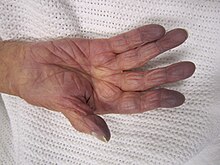| Cyanosis | |
|---|---|
 | |
| Cyanosis of the hand of a patient with low oxygen saturations | |
| Specialty | Pulmonology, cardiology |
| Symptoms | Hyperthermia, numbness in the area where the cyanosis is, coughing, wheezing, difficulty breathing |
| Types | Circumoral, central, peripheral |
| Causes | Airway problems, lung problems, heart problems, exposure to extreme cold |
| Differential diagnosis | Circumoral cyanosis, peripheral cyanosis, central cyanosis |
| Prevention | Avoid exposure to freezing cold temperatures, limit smoking or caffeine, avoid touching cyanide |
| Medication | Antidepressants, anti-hypertension medication, or if caused by other reasons, naloxone hydrochloride |
Cyanosis is the change of body tissue color to a bluish-purple hue, as a result of decrease in the amount of oxygen bound to the hemoglobin in the red blood cells of the capillary bed.[1] Cyanosis is apparent usually in the body tissues covered with thin skin, including the mucous membranes, lips, nail beds, and ear lobes.[1] Some medications may cause discoloration such as medications containing amiodarone or silver. Furthermore, mongolian spots, large birthmarks, and the consumption of food products with blue or purple dyes can also result in the bluish skin tissue discoloration and may be mistaken for cyanosis.[2][3] Appropriate physical examination and history taking is a crucial part to diagnose cyanosis. Management of cyanosis involves treating the main cause, as cyanosis isn’t a disease, it is a symptom.[1]
Cyanosis is further classified into central cyanosis and peripheral cyanosis.
- ^ a b c Adeyinka, Adebayo; Kondamudi, Noah P. (2021), "Cyanosis", StatPearls, Treasure Island (FL): StatPearls Publishing, PMID 29489181, retrieved 2021-10-28
- ^ Dereure, Olivier (2001). "Drug-Induced Skin Pigmentation: Epidemiology, Diagnosis and Treatment". American Journal of Clinical Dermatology. 2 (4): 253–262. doi:10.2165/00128071-200102040-00006. ISSN 1175-0561. PMID 11705252. S2CID 22892985.
- ^ Conlon, Joseph D; Drolet, Beth A (2004). "Skin lesions in the neonate". Pediatric Clinics of North America. 51 (4): 863–888. doi:10.1016/j.pcl.2004.03.015. PMID 15275979.